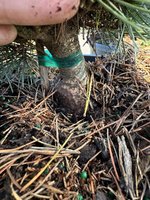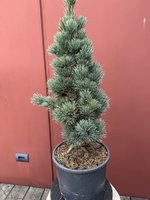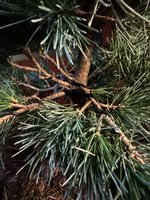'Aoi' is a very nice cultivar of JWP for bonsai. I agree your "tree" is most likely in the first whorl or possibly first and second whorl of the branches. My question is how does the graft union look? A photo with the lens of camera level with the rim of the pot towards the graft union would be good. I have had grafted trees where the choice of front had to be done based on the graft union, as one side the graft was invisible and the other side was a horrible scar.
Only Iseli nursery can answer with certainty what the current understock used is but I believe a number of years ago they were asked and said they were using Pinus contorta, lodgepole pine, an inland seed source that would be hardy through zone 4. This way their grafted trees would be hardy throughout the lower 48 states, which is their market. Pinus contorta latifolia is the lodgepole pine and is very winter hardy, thru zone 4. Pinus contorta contorta is the shore pine and is only zone 7 hardy.
Understock was a problem with Japanese imported JWP. The Japanese and some North American bonsai nurseries used Japanese black pine, Pinus thunbergii as understock. This was because JBP has great bark and in time the understock would fuse nicely to the JWP trunk yielding a tree with dramatic bark at the base the transitioned to JWP bark higher up in the tree. Aesthetically this is the proper way to go, for best appearance, however this meant the resulting JWP was only as hardy as the understock, meaning zone 7, or zone 6 with good protection. I lost a couple JWP in my early years think JWP would be hardy in my area, not thinking about the JBP understock.
North American landscape nurseries usually use Pinus contorta latifolia, or maybe Pinus sylvestris, the Scots pine. North American Bonsai nurseries often use JBP again for the better bark texture. Though it can vary. You can certainly email and ask before you buy.
Nothing wrong with the bark of Pinus contorta latifolia, lodgepole pine as understock, it has a plated bark that is not wildly different than a mature JWP. The transition is not bad. It is not as dramatic as JBP on an old tree but it is acceptable.




























